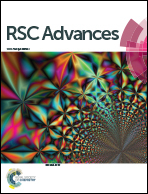A green method to gold–graphene nanocomposite from cyclodextrin functionalized graphene for efficient non-enzymatic electrochemical sensing applications†
Abstract
Here, we report a new and green method of synthesis of gold nanoparticle functionalized graphene (Au–Gr) from β-cyclodextrin functionalized Gr (CD–Gr). The CD–Gr, made from CD and reduced graphene oxide (Gr), is dispersible in water and various other solvents and yields individual Gr sheets of ∼2 nm thickness in aqueous suspension. The aqueous suspension of CD–Gr on heating with chloroauric acid forms Au–Gr. The CD molecules act as the reducing agent for Au(III) ions to form Au–Gr. The formation of Au–Gr is confirmed by various techniques such as UV-visible spectroscopy, scanning and transmission electron microscopy, X-ray diffraction etc. The procedure successfully produces silver functionalized Gr (Ag–Gr) also. The method utilizes just water and CD and hence is benign to the environment. The Au–Gr exhibits excellent electrochemical sensing property with the best detection limits for biomolecules such as glucose and ascorbic acid with 10 and 40 nM, respectively, compared to that reported in the literature by any enzymatic or non-enzymatic electrodes. The excellent sensing property of Au–Gr is attributed to the synergistic effects of the high conductivity and catalytic activity of Gr and Au, respectively and the better homogeneity, dispersibility, surface area and adsorption achieved due to the presence of CD.


 Please wait while we load your content...
Please wait while we load your content...